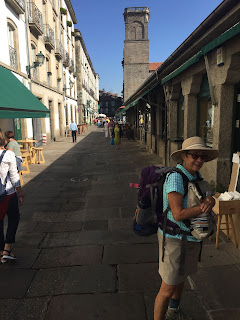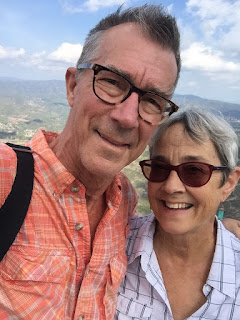So on September 18th, we left Barcelona and flew to Santiago. Santiago has a population of 96,000, that is swelled by the hundreds of pilgrims that arrive every day. It is a quaint old town, with narrow streets, and many restaurants. There are many churches, so even though the Cathedral is under restoration, and holding Masses, there are churches all over the city where they have Masses for the Pilgrims, in various languages.
After a night here in a small hotel, we walked across town with our packs to the bus station, and took a bus to Ponferrada. Our original plan was to bus to Sarria, and hike the last 100 kilometers of the Camino, back to Santiago. But our first night here, we encountered two different people that told us it was too crowded, and would not give us a good impression of the Camino. Evidently, you can get a certificate of completing the Camino (and thereby have your sins forgiven), by walking the last 100 km, and many people do that.
There is a saying on the Camino, "Everyone walks their own Camino." So there are tour companies that line up hotels for every stop along the way. There are also public "albergues" or hostels in many small villages. Some pilgrims walk until they are tired, with their pack on their back, and trust that the albergue will have a bed for them. David and I decided that we loved the idea of someone transporting our packs to the next hostel, but that meant we had to decide the night before where we were staying the next night. We also decided that 15 km, or a bit less than 10 miles, was a good day's walk for us, since we had already walked a couple of 12 or 13 mile hikes at Douthat State Park in August. Early on, while we were planning the trip, we decided to stay in the albergues, instead of hotels.
Every albergue was different. We stayed in two public albergues, one in a monastery that had over 50 beds in one huge room (fortunately only 20 people stayed that night), and a municipal albergue that had 12 beds to a room. They all had showers. One night we stayed in an albergue that had private rooms, so I could get a good night's sleep. Even with earplugs, the snoring could wake me up in the communal rooms. Some had kitchens for people to cook in, but we always went to a restaurant for dinner. They offered a pilgrim's meal, three courses plus a bottle of wine, for ten euros. Usually there was a choice of entree, but sometimes not. Our favorite experiences were in the small towns.
I was happy that I knew a bit of Spanish, but many shopkeepers and servers knew enough English to take care of our needs. Many of our fellow pilgrims also spoke some English. Our fellow hikers were French, British, Australian, German, Austrian, Belgian, Japanese, Irish, Ukrainian, Polish, and American. Many were doing the whole 700 mile trek, and many were doing it for the second time. Some were like us, and just doing it for a period of time. The ages ranged from 17 to mid-seventies.
Walking up and down hills, sometimes on a path next to a road, but usually through woods or vineyards, gave me a lot of time to think. We also sang and talked. I was very glad to have a companion at my side. I thought a lot about what retirement will mean for me, what makes me feel good about myself, and what I want to focus on right now. I want to be kind, have more patience, and show forgiveness. I want to also do those things with myself. I want to let people live in all the various ways that they do, and not judge them. I want to allow everyone to walk their own Camino.
Some highlights, day by day.
Ponferrada:
Castle
One of the Camino signs at the beginning of our hike. We never got lost. There were Camino signs at every fork. Sometimes we would wonder if we were on the right path going through a town, and then we would see a scallop shell or a yellow arrow painted on a wall or the road to guide us.
La Siesta was the smoothie trailer that we encountered next to the stream, in the woods near Cacabelos. And he had vegan food!!
Before we left Santiago for Ponferrada, we loaded up for lunch at the market. I had two packs on for the bus trip.
David enjoying an end of the hike beer at our albergue in Cacabelos.
Day 2 of the hike:
Just one of many churches we saw in the countryside. Notice that they have to climb stairs to a porch to ring the bells. There were also very small chapels as well, on the side of the Camino.
 We walked through vineyards of ripe grapes all day, and one of the grape pickers offered us each a bunch of grapes to eat. They were really sweet!
We walked through vineyards of ripe grapes all day, and one of the grape pickers offered us each a bunch of grapes to eat. They were really sweet!
I do not have any pictures of Pereje, one of our favorite villages. They had a municipal albergue there, one restaurant, and maybe 10 houses. It started raining that afternoon, so that restaurant was very busy, but we had our first pilgrim meal there: A pitcher of wine, lentil soup, trout, french fries and salad, and flan for 10 euros. The same waiter took care of everyone all afternoon and evening, and also served the coffee and Santiago cake the next morning.
Dairy cows in Las Herrerias. They all wear bells, and we heard them all day long, but fortunately not at night. We got a private room in an albergue here, so we got a good night's sleep without the snoring of other folks. We were still on the path by 9:00 am.
Here is the beginning of the climb to O Cebreiro, a 600 meter climb in 8 km. We were so tired when we got there, we forgot to take pictures. It is a really old medieval town, that has a couple of old thatched structures. Many tour buses drive up there, and several tourists took pictures of us because we looked like real pilgrims!
This was our only day of really vile weather, as our British friends called it. We stayed in an albergue the previous night that did not have a restaurant in the same village. So breakfast was a 3 km hike away. It was raining hard, and windy. So we took a taxi to the next town to get our breakfast. By the time we had coffee and toast with butter and jam, we were ready to brave the weather. My hat did not keep the rain off my glasses, so eventually I hiked without my glasses. Fortunately, it was a wide clear path. When we were really soaking wet and miserable, we stopped at a cafe for coffee and sandwiches. We stayed there over an hour, till our pants were dry. By the time we left, the rain was mostly gone.
Day 5 -This region had so much slate, they used it on porches, fences, and roofs. Notice the yellow arrow painted on the stone wall.
One of the inner courtyards of the monastery, which we toured. Only 8 monks live in this monastery from the 12th century in 11,000 square meters. At least they have an albergue in part of it, and a mass for pilgrims every evening. Much of it was destroyed by a fire in 1951 which started in their distillery. It has been completely restored.
 |
| David giving me a foot massage in Sarria, on the terrace of the albergue |
 |
| Arriving in Santiago |
 |
| In Santiago for three days of relaxation |





































































